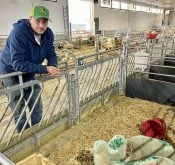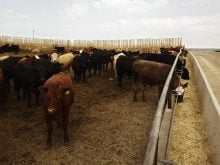BANFF, Alta. – Extracting the benefits of barley is still at the
laboratory stage, but University of Alberta researchers are confident
they can add healthy components of the grain to a variety of common
foods.
The critical element is beta glucan, a soluble fibre known to lower
cholesterol and regulate blood glucose levels.
Led by researchers Thava Vasanthan and Feral Temelli, the work will
continue through a recently formed company, Cevana Bioproducts Inc. It
received $2.3 million from AVAC Ltd. and Foragen Technologies
Read Also

Solar, sheep provide valuable farm diversification
Eric Steeves says raising sheep on forages grown under solar panels provided economic stability and perhaps even saved his family’s fifth generation southern Alberta grain farm.
Management Inc., investment companies that fund value-added food
companies.
They are concentrating on waxy barley varieties that contain up to
seven percent beta glucan, compared to regular varieties with about
five percent.
Other byproducts may be used for cosmetics and industrial purposes like
modified starch for bioplastics and papermaking.
“We’re developing applications for all the fractions so we are using
every part of the kernel,” said Temelli in an interview at the Alberta
Barley Commission’s annual meeting Dec. 6.
The most promising food products are two beverages and a low fat
breakfast sausage. The sausage incorporates beta glucan as a fat
replacement. It binds when wet and has the slippery feel of fat.
Canada does not have regulations in place to allow labelling of barley
based products as a healthy food like oats. However the researchers are
confident beta glucan in barley will be recognized.
The United States Food and Drug Administration said three grams of beta
glucan per day can help reduce the risk of heart disease.
“To put a product claim on your product label, that product has to
contain 0.75 grams of beta glucan per serving,” Temelli said.
That means four servings of that product are needed to receive the full
benefit.
Getting enough to do any good has been a problem in the past. For
example, to get the full benefit of oats’ cholesterol-lowering
abilities, a person has to eat four bowls of cereal a day. It is
therefore better to extract the most valuable components and add them
to other food products, such as drinks or energy bars.
The Alberta Barley Commission and Alberta Agricultural Research
Institute provided most of the research money for these food products.
When the food company was formed, the University of Alberta offered the
commission an equity share in the company at no charge. However, the
commission’s governing authority, the Alberta Marketing Council, vetoed
the venture.
“It wasn’t a high risk. It was merely an opportunity of return on
research dollars,” said Alex Hamilton, who heads the commission’s
research committee.
The commission hopes to find a means to invest in such companies to
return the earnings to farmers.















